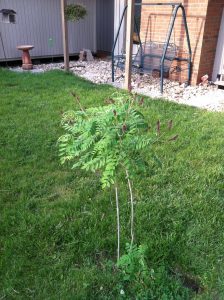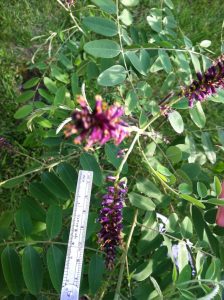Q. I have discovered an infestation of what I believe to be aphids of some sort on the stems of my Victoria Salvia and Chamomile plants. They are dark and tear-shaped of various sizes, and the ants are attracted to the “honey-dew” that the insects are making. I have sprayed them with liquid Sevin, but it does not seem to have knocked them out completely. What do you recommend to fight these? – JG
A. There are numerous species of aphids that feed on horticultural plants and can rapidly increase to alarming numbers. They are typically found on the underside of leaves and along young, actively growing stems. Ants are indeed often found feeding on the sticky aphid poop often referred to as “honeydew.” You may already have had some natural controls in your garden; lady beetles and lacewings are effective predators of aphids. Unfortunately, spraying with Sevin insecticide would destroy these natural control agents, as well as bees and other beneficials. And a single application of any insecticide is unlikely to provide complete control; once the natural enemies have been killed, the aphid population will recover more quickly.
A sharp spray from the garden hose with just plain water can knock down the population of aphids to a level that the natural predators might be able to keep up with. Failing that, an insecticidal soap product, which is labeled for use on flowers and herbs, can be used to help reduce the aphid numbers. Always read and follow the label directions for appropriate application rates. Too much soap will damage the plants, and too little soap will not provide effective results.
Q. The attached pictures are of a tree that has appeared in our backyard. As you can see in the first shot, the blossoms are about 2 1/2 inches long. They have a “diesel-fuel” smell. – TL
A. This looks to be indigobush amorpha, Amorpha fruiticosa, a native but frequently weedy (invasive) plant. While the flowers are interesting, the plants put on a tremendous seed crop, resulting in uninvited specimens. In fact, this species is banned/quarantined in some states. Might be best to remove this from your collection before it gets out of control.
Q. We have a problem with our peonies. They have been here for years. They used to be big and bloom like crazy. For years, they have not done anything. They are real thin bushes with no blooms. One is really bushy, but no blooms. We did have one flower this year. They are in the sun most of the day. Can you tell us anything to do for them? We miss our peonies. – VM
A. Peonies notoriously produce a lot of foliage with little or no flowers if they are either too shady or, more commonly, when planted too deep. Adding mulch annually or leaf litter from nearby trees can effectively make the tubers too deep. Since you mention that they used to flower well and are in the sun most of the day, your plants would likely benefit from lifting and resetting at the proper depth. Lift the plants in late summer or early fall, and replant so that the buds on the tubers are no deeper than two inches.

